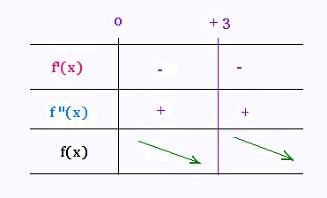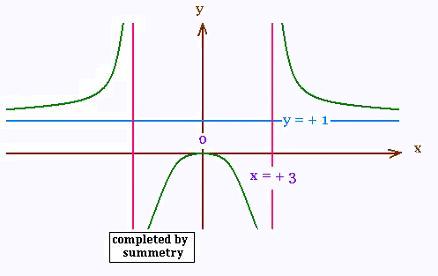Calculus I
Limits
Derivative
Exercices
Applications
Marginal analysis
© The scientific sentence. 2010
|
Calculus I: Graphing a function
1. How to graph a function
Let f a function. To study f, we proceed by the following steps:
- Find the domain of the function,
- Set the continuity of this function,
- Determine the parity of the function,
- Determine its asymptotes,
- Derive is f(x) and determine the critical numbers
and the relative extrema of the function.
- Set f"(x) and the numbers of transition and the
inflection points.
- Construct the sign-variation table of the function
including the variation of f and its concavity.
- Draw the graph.
2. Example:
f(x) = (x2 + 3)/(x2 - 9)
- Domain D = R / {- 3, + 3}
- f is discontinuous at x = - 3 and x = + 3,
lim f(x) = 12/0- = - ∞
x → - 3-
lim f(x) = 12/0+ = + ∞
x → - 3+
lim f(x) = 12/0- = - ∞
x → + 3-
lim f(x) = 12/0+ = + ∞
x → + 3+
- f is even because f(- x) = f(x)
The interval of symmetry is [0, + ∞[
-
The asymptotes are:
Vertical: x = - 3 and x = + 3
Horizontal:
lim f(x) = lim (x2/x2) = 1
x → ± ∞
- f'(x) = - 24 x /(x2 - 9)2
x = 0 f(0) = - 1/3
x = 0 exists in the domain D. So this point
is a critical point. The point (0, - 1/3) is an extremum.
- f"(x) = (72 x2 + 216)/(x2 - 9)3
f"(x) = 0 has no solutions. So there are no numbers of transition
or inflection points.
f "(0) = 216/(- 9)3 < 0 . So
the point x = 0 is a relative maximum of f and the
concavity is downward (convex).
-

-

3. Exercises
A homographic function f is defined as:
f(x) = (ax + b)/(cx + d)
where a, b, c, and d are real constants.
- D = R \ {- d/c}
- f is discontinuous at x = - d/c
lim f(x) = 12/0± = ± ∞
x → (- d/c)±
The line x = - d/c is a vertical asymptote.
lim f(x) = a/c
x → ± ∞
The line y = a/c is a horizontal asymptote.
- The function is neither even nor odd, so
we study the function in the whole domain D.
-
There is no oblique asymptote because the function has
already a horizontal asymptote.
-
f '(x) = (ad - bc)/(cx + d)2
has no solutions.
So no critic points, then
no relative extrema.
The function is increasing if (ad - bc) >0,
and decreasing if (ad - bc) <0.
- f"(x) = - 2 c (ad - bc)(cx + d)/(cx + d)4
f"(x) = o when x = - d/c
This point x = - d/c D, so it is not a
transition number, then not an inflection point. D, so it is not a
transition number, then not an inflection point.
Using the division of polynomials, we can write:
f(x) = (ax + b)/(cx + d) = (a/c) + (1/c)(bc - ad)/(cx + d)
and we see y = a/c is a particular oblique asymptote,
that is a horizontal asymptote.
We can also remark that this function f(x) is transformed
by a translation from the function fo(x) = 1/x,
with (a/c) vertically, and (- d/c) horizontally. Hence the word
homograph i.e. same graph.
- Construct the sign-variation table of the function
including the variation of f and its concavity.
- Draw the graph.
|
|

